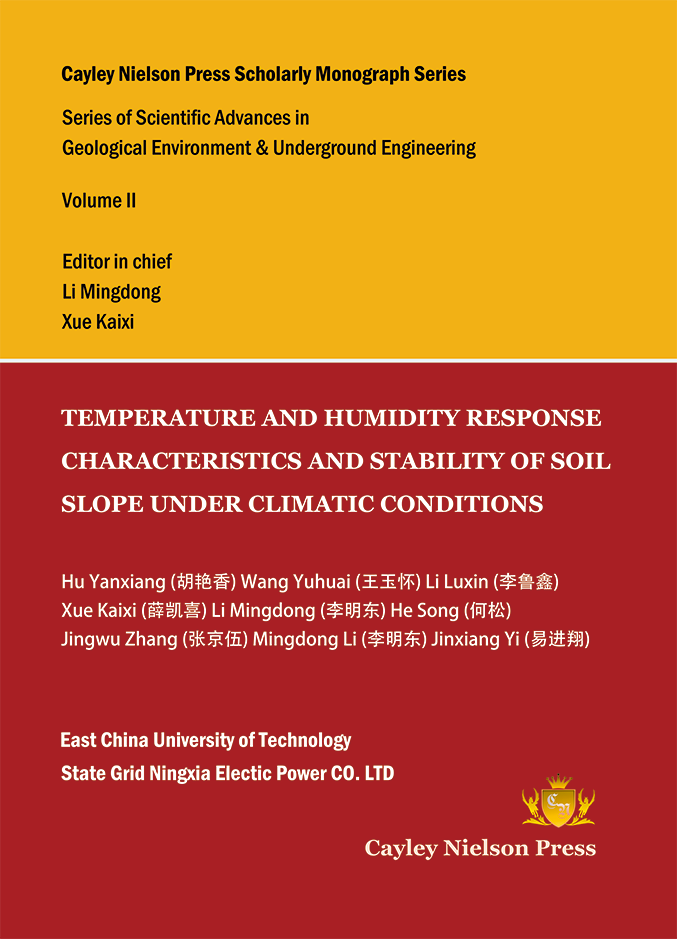
TEMPERATURE AND HUMIDITY RESPONSE CHARACTERISTICS AND STABILITY OF SOIL SLOPE UNDER CLIMATIC CONDITIONS

TEMPERATURE AND HUMIDITY RESPONSE CHARACTERISTICS AND STABILITY OF SOIL SLOPE UNDER CLIMATIC CONDITIONS
Hu Yanxiang(胡艳香),WangYuhuai(王玉怀),Li Luxin(李鲁鑫),Xue Kaixi(薛凯喜),Li Mingdong(李明东),He Song(何松)
East China University of Technology
State Grid Ningxia Electic Power CO. LTD
Copyright © 2022 by Cayley Nielson Press, Inc.
ISBN: 978-1-957274-04-1
Cayley Nielson Press Scholarly Monograph Series Book Code No.: 212-4-3
Series of Scientific Advances in Geological Environment & Underground Engineering, Volume II
Editor in chief: Li, Mingdong and Xue, Kaixi(李明东,薛凯喜)
Editors: Yi, Jinxiang; Zhang, Jingwu; Zhu, Liping; Yang, Ting; Xu, Tao; Wang, Shengfu; Shan, Lingzhi; Wan, Yukuai (易进翔,张京伍,朱丽萍,杨婷,许涛,王升福,单凌志,万愉快)
US$150.00
Preface
Taking the typical soil slopes in Jiangxi Province as the research object, with the support of the National Natural Science Foundation Project (42167024) - "Research on disaster pregnant mechanism and disaster mode of rainfall layered soil landslide", through field investigation, indoor and outdoor tests, numerical simulation and other technical means, eight typical extreme weather conditions were selected to systematically study the water holding characteristics and deformation response characteristics of soil slope. At the same time, six numerical simulation tests of slope response with simple rainfall parameters as independent variables are carried out, and the above two cases are compared and analyzed. The main research contents and results are as follows:
(1)The response characteristics of seepage field, temperature field and evaporation field of soil slope under different climatic conditions are systematically studied. The results show that under various working conditions, the change of seepage field shows that the shallow response is strong, the deep response is not significant, and the response degree is greatly affected by the parameter value. The pore water pressure of soil increases with rainfall and decreases with drought. The change rate is related to the degree of rainfall and drought degree. Under the action of various working conditions, the temperature field in the slope varies greatly, which is mainly manifested in the dense distribution of isotherms in the shallow surface layer and the temperature field at the bottom. The variation of evaporation under each working condition has a certain regularity, which is mainly related to temperature and wind speed. When the parameters are the same, the evaporation under any working conditions is roughly the same, and the daily evaporation decreases slightly with the increase of duration.
(2)The monitoring values of pore water pressure, real-time temperature and other parameters at different locations and depths are compared and analyzed. The results show that the relationship between pore water pressure values at different locations is slope top, slope shoulder > slope toe and slope bottom. The temperature variation law at each position is basically the same. The change rate of pore water pressure at nodes with different depths has a great difference, which is shallow nodes > deep nodes, and almost no influence after reaching a certain depth. The node temperature at each depth shows that the shallow surface response is intense, the deep response is not obvious, and the soil temperature below 4.5m from the surface is almost unaffected by the outside world.
(3)After analyzing the slope stability under different climate and rainfall conditions, the results show that the safety factor of the slope under various conditions is quite different. The gradient value relationship of the safety factor is climate (high temperature) > climate (normal temperature) > single rainfall condition.
(4)According to the comprehensive analysis of the slope based on the actual climatic conditions of Nanchang in 2015, the variation rules of seepage field, temperature field and evaporation field were consistent with the above research rules. Under the action of annual climate, the safety factor of slope shows seasonal variation, which is mainly related to the fact that the safety factor in autumn and winter is greater than that in spring and summer.
Hu Yanxiang
East China University of Technology
Nanchang, Jiangxi, China
May 10, 2021
Contents
Chapter 1 Introduction 1
1.1 Research background and significance 1
1.2 Research status at home and abroad 3
1.3 Main Research Contents and Methods 13
1.4 The Innovation Point 15
Chapter 2 Survey of the Study Area and Soil Engineering Characteristics 18
2.1 Overview of the Study Area 18
2.2 Physical and Mechanical Properties of Red Clay Slope Soil 19
2.3 Hydraulic characteristics of unsaturated red clay 23
2.4 Thermophysical Properties of Unsaturated Red Clay 30
2.5 Chapter summary 34
Chapter 3 Introduces the Numerical Simulation Software and Builds the Model 35
3.1 Introduction to Geostudio Software 35
3.2 Construction of geometric model 39
3.3 Construction of physical model 42
3.4 Chapter summary 44
Chapter 4 Temperature and Humidity Response Characteristics of Slope Soil under the Action of Climate 46
4.1 Temperature and humidity response characteristics of red clay slope under multiple climatic factors 46
4.2 Seepage Response Characteristics of Red Clay Slope under Single Amount of Rainfall 86
4.3 Differentiation Analysis under Two Conditions 101
4.4 Chapter summary 117
Chapter 5 Comparative Analysis of the Stability of Red Clay Slope under the Effect of Climate the wetting and Drying Cycle is Slightly Weakened but not Obvious 109
5.1 Selection of Calculation Methods 127
5.2 Stability Analysis of Red Clay Slope under Multiple Climatic Factors 127
5.3 Stability Analysis of Red Clay Slope Under Single Amount of Rainfall 130
5.4 Differentiation Analysis under Two Conditions 138
5.5 Summary of this Chapter 138
Chapter 6 Temperature and Humidity Response Characteristics and Stability of Red Clay Slope under Climate Change throughout the Year 140
6.1 Summary 140
6.2 Selection and setting of parameters 143
6.3 Analysis of Calculation Results 143
6.4 Chapter Summary 143
Chapter 7 Conclusion and Prospect 140
7.1 Conclusion 140
7.2 Suggestion 143
References 145
Readership
This book should be useful for students, scientists, engineers and professionals working in the areas of optoelectronic packaging, photonic devices, semiconductor technology, materials science, polymer science, electrical and electronics engineering. This book could be used for one semester course on adhesives for photonics packaging designed for both undergraduate and graduate engineering students.
